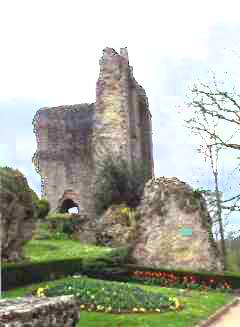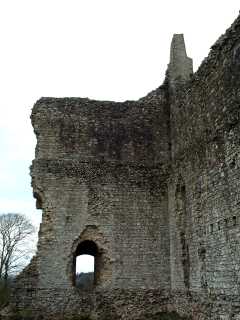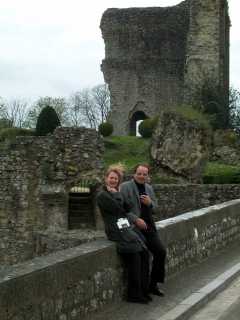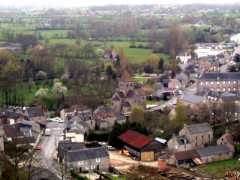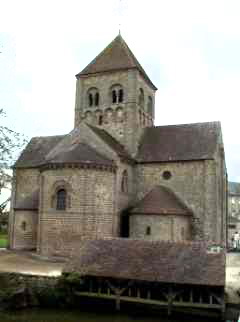Domfront was a strategic
point on the ancient borders of Normandy, Maine (once part of
Anjou) and Brittany. It was defended and attacked by the most
powerful men of the eleventh and twelfth centuries. This in turn
gave Briouze, the next castle north of Domfront, a major role
in Normandy's defences. The power and significance of the de
Braose family can be measured by the importance of Domfront.
Domfront castle overlooks
the wide expanse of the Varenne Valley, on a spectacular craggy
hilltop three hundred feet high. The castle was originally built
by William de Belleme I in 1010. William the Conqueror gained
it from Geoffrey Martel, Duke of Anjou in 1055 and Domfront's
fortifications were strengthened by successive dukes and kings.
Many historic military campaigns centred on Domfront. It was
still a potential threat in 1608 after the Wars of Religion,
when the goverment blew it up with gunpowder and left the ruins
that are seen today.
Claude and Lynda posed for a photograph
at Domfront Castle.
Eleven of the original
twenty four medieval towers which defended the town still survive.
It is amazing to see that some of these towers are now comfortable
houses and offices. The walls of the town and its many beautiful
old buildings are a delight for anyone interested in the medieval
past.
Far below the castle is
the church of Notre-Dame Sur L'Eau, established by William de
Belleme in about 1020.
Notre-Dame Sur L'Eau was
attached to the Abbey of Lonlay. It stands on an ancient route
for pilgrims travelling between Mont Saint Michel in Normandy
and the shrine of Saint James of Compostela, in Spain. Weary
pilgrims slept on the stone floors of the church but it was an
inspiring experience for many. Illustrious visitors such as Thomas
Becket, Eleanor of Aquitaine, Richard the Lion Heart and Saint
Louis added to the mystery and prestige of Notre-Dame Sur L'Eau.
The church has preserved several twelfth century wall paintings and the architecture which has survived the centuries is remarkable. Among the treasures of Notre-Dame Sur L'Eau is this fourteenth century Madonna and Child.
|
© Lynda Denyer, Steyning,
2000 |

